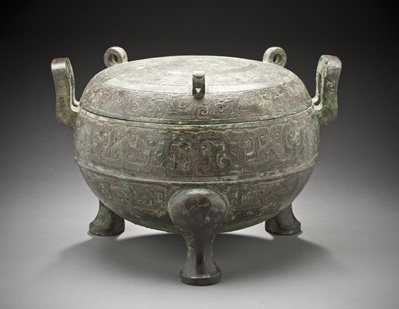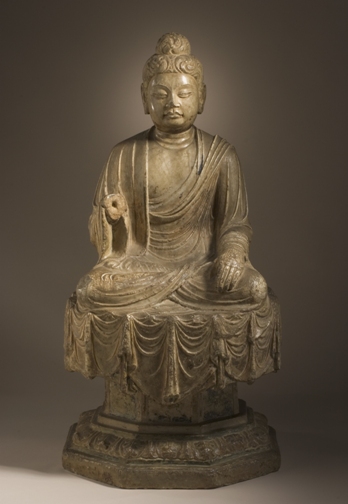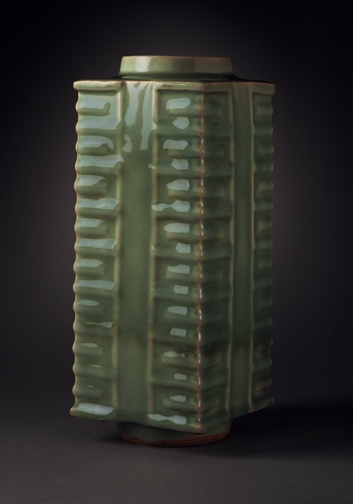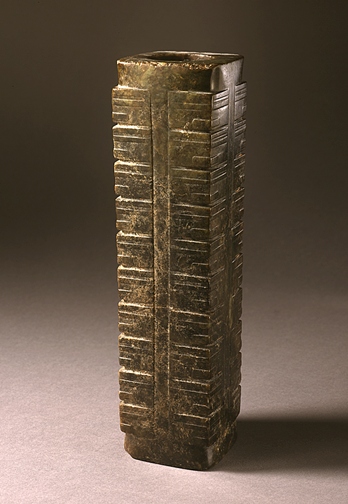About half a year ago, Stephen Little (curator and head, Chinese and Korean Art) and I both arrived to the museum. Our first mission was to bring LACMA’s collection of Chinese art back on display. As of this past weekend, approximately forty objects are now on view. The reinstalled gallery is designed to tell the history of art in China, with each dynasty distinguished by examples that reflect the aesthetics, technology, and ideology of their time period. To achieve this goal, nothing is more illuminating than our best-known pieces. One of the most celebrated early Chinese artworks from LACMA’s collection is a cauldron called ding from the Zhou dynasty (1046–256 BC). This ding is from a set that would include more vessels of different shapes and sizes. Called mingqi in Chinese, meaning “spirit objects,” such sets were used during burial rituals and ceremonies conducted for ancestors, and demonstrate the importance of ancestral worship in the early times of Chinese civilization.

Lidded Ritual Food Cauldron (Ding) with Interlaced Dragon, China, Shanxi Province, ancient state of Jin, middle Eastern Zhou dynasty, about 500–450 BC, gift of Mr. and Mrs. Eric Lidow
Equally famous is a seated Buddha carved of marble. The Buddha has been part of LACMA’s Chinese art display since the 1940s as a long-term loan, until officially entering the museum’s permanent collection in 2007. With a serene face and gracefully proportioned body, the Buddha exemplifies the highest achievement of Buddhist art in China.

Probably Shakyamuni (Shijamouni), the Historical Buddha, China, middle Tang dynasty, about 700–800 AD, gift of Ruth Trubner in memory of Henry Trubner and purchased with funds provided by Kelly and Robert Day, H. Tony and Marti Oppenheimer and the Oppenheimer Brothers Foundation, David Bohnett and Tom Gregory, Ric and Suzanne Kayne, Richard Merkin, M.D., Lenore and Richard Wayne, Sharon and Robert Blumenfield, Edgerton Foundation, Myron Laskin, Mary and Robert Looker, Nancy and Dick Riordan, and Mr. and Mrs. Hazelle Hickman
While showcasing these masterpieces of different time periods and medium, I also wanted to convey the continuity of art making in China. Chinese culture has always valued and revered history and tradition. Imitating the past is considered the necessary first step of learning and is a source for creativity. Archaism is a reoccurring theme over centuries. On display is a longquan-ware vase in the shape of a cong, not far different from a jade cong of the Neolithic period. Cong refers to the geometric shape that combines a circle and a square. The circle symbolizes heaven and the square symbolizes earth in early civilization. Together they present the dual-system of yin and yang that is still important in Chinese philosophy and ideology today.

Vase (Ping) in the Form of an Archaic Jade Ritual Tube (Cong), China, Zhejiang Province, Southern Song dynasty, 1127–1279, gift of Carol Holmes

Square Tube (Cong) with Masks, China, Neolithic period, Liangzhu culture, about 2600–2400 BC, gift of Carol Holmes
A jade disk from the middle Ming dynasty (1368–1644) is decorated with dragons on one side and raised bosses with spirals on the other. Its design—the donut-like shape and the raised spirals—is also inspired by a Neolithic piece.

Perforated Disk (Bi) with Dragons, China, late Ming dynasty, about 1550–1644, gift of the Marcia Israel

Perforated Disk (Bi) with Relief Spirals, China, late Eastern Zhou dynasty, 481–221 BC, gift of Carl Holmes
We are very glad to have LACMA’s outstanding Chinese collection back in the galleries. More treasures will be put on display in the rotations in the coming months. Christina Yu Yu, Assistant Curator, Chinese Art



